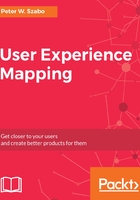
上QQ阅读APP看书,第一时间看更新
User Story Map - Requirements by Collaboration and Sticky Notes
User story maps are the most common and popular map types by far. In this chapter, we will explore user story maps, and how they help you to create requirements through collaboration (and a few sticky notes). We will do the following in this chapter:
- We will create user stories and arrange them as a user story map
- We will discuss the reasons behind creating them
- We will cover how to tell a story
- The grocery surplus webshop's user story map will be the example I create in this chapter
- To do this, we will explore user story templates, characteristics of a good user story (INVEST) and epics
- With the three Cs (card, conversation, and confirmation) process, we will turn the stories into a reality
- We will create a user story map on a wall with sticky notes
- Then, create it digitally using StoriesOnBoard
User stories are atomic functionality pieces, which provide value to the user. They are used to facilitate a conversation.
Jeff Patton wrote the first article about the subject in 2004, and a decade later in the book titled User Story Mapping, O'Reilly Media, 2014. Most people agree that he coined the term user story map, so it's only fair that we start this chapter with a quote from Jeff:
Story maps are for breaking down big stories as you tell them.
- Jeff Patton
Systematically putting together atomic and valuable functionality pieces will produce a user story map.